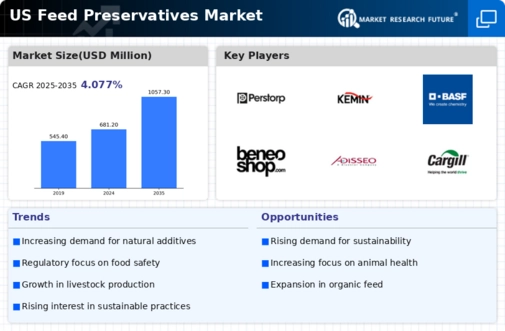Rising Demand for Animal Nutrition
The increasing focus on animal nutrition is a pivotal driver for the feed preservatives market. As livestock producers strive to enhance the quality of animal feed, the demand for effective preservatives rises. In the US, the livestock sector is projected to grow, with an estimated value of $200 billion by 2025. This growth is likely to spur the need for preservatives that maintain feed quality and prevent spoilage. Moreover, the emphasis on improving feed efficiency and animal health further propels the market. Feed preservatives play a crucial role in ensuring that feed retains its nutritional value, thereby supporting the overall health of livestock. Consequently, the rising demand for high-quality animal nutrition is expected to significantly impact the feed preservatives market, driving innovation and product development in this sector.
Expansion of the Livestock Industry
The expansion of the livestock industry is a crucial driver for the feed preservatives market. As the demand for meat, dairy, and other animal products continues to rise in the US, the need for effective feed preservation becomes increasingly important. The livestock sector is projected to grow significantly, with estimates suggesting an increase in production value by 4% annually. This growth necessitates the use of preservatives to ensure that feed remains fresh and nutritionally viable throughout its shelf life. Additionally, the expansion of the livestock industry is likely to lead to greater investments in feed technology, further propelling the feed preservatives market. As producers seek to optimize feed quality and minimize waste, the role of preservatives in maintaining feed integrity will become even more pronounced.
Increased Awareness of Animal Welfare
The growing awareness of animal welfare is a significant driver for the feed preservatives market. Consumers are increasingly concerned about the conditions in which livestock are raised, leading to a demand for products that ensure the health and well-being of animals. Feed preservatives contribute to this by preventing spoilage and maintaining the nutritional integrity of feed, which is essential for animal health. In the US, the market for organic and natural feed products is expanding, with an estimated growth rate of 7% annually. This trend suggests that as consumers prioritize animal welfare, the demand for high-quality feed preservatives will likely increase. Consequently, the feed preservatives market is expected to adapt to these changing consumer preferences, focusing on products that align with animal welfare standards.
Regulatory Compliance and Food Safety
Regulatory compliance and food safety standards are increasingly influencing the feed preservatives market. In the US, stringent regulations imposed by agencies such as the FDA and USDA necessitate the use of preservatives to ensure the safety and quality of animal feed. These regulations aim to prevent contamination and spoilage, thereby protecting both animal health and consumer safety. As a result, feed manufacturers are compelled to adopt preservatives that meet these regulatory requirements. The market for feed preservatives is projected to grow at a CAGR of 5% through 2025, driven by the need for compliance with these regulations. This trend indicates that the feed preservatives market is not only responding to consumer demands but also adapting to the evolving regulatory landscape, which is crucial for maintaining market viability.
Technological Innovations in Preservation Techniques
Technological innovations in preservation techniques are reshaping the feed preservatives market. Advances in biotechnology and chemical engineering have led to the development of more effective preservatives that enhance feed stability and shelf life. In the US, the adoption of these innovative technologies is expected to drive market growth, with a projected increase of 6% in the next few years. These innovations not only improve the efficacy of preservatives but also address consumer concerns regarding the safety and environmental impact of feed additives. As a result, the feed preservatives market is likely to witness a surge in demand for products that leverage these technological advancements, reflecting a broader trend towards modernization in the agricultural sector.



















Leave a Comment